27.07.2006
THE EXPERT`S CHOICE: VITIUGOV`S COMMENTARY
IZORIA – GAGUNASHVILI B48
Kusadasi 2006
1.e4 c5 2.¤f3 e6 3.d4 cxd4 4.¤xd4 ¤c6 5.¤c3 Јc7 6.Ґe3 ¤f6.

Ingenious order of moves. Black tries to avoid Paulsen variation with Ґе3 and Јd2. But it is natural that now White has new opportunities. Izoria tried one of these opportunities in this game. Once I mixed up the order of moves playing against Boris Savchenko in 2004. Since then I prefer mixing up the order of moves in this variation.
7.f4 Ґb4. After cowardly 7...d6 it is unclear for what Black moved his queen on c7. This kind of Scheweningen variation is unfavorable for Black.
8.¤db5 Јa5 9.e5 a6. The concrete approach to the position. Black strikes back. 9...¤e4 seems to be alternative move. After 10.Јd3 Black is at the crossroads. The European ex-champion tried 10...f5 11.exf6 ¤xf6 12.¤d6+ Ґxd6 13.Јxd6 ¤e4 14.Јd3 ¤xc3 15.Ґd2 0–0 16.bxc3 e5 17.c4 Јb6 18.0–0–0 d6 19.Јd5+ ўh8
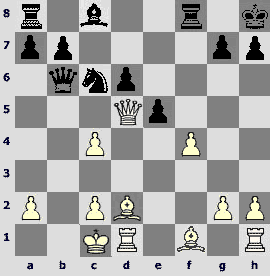
The opponents agreed to a draw in this unclear position, Kulaots – Nisipeanu, Turin 2006. And world ex-champion Alexander Khalifman tried 10...¤xc3 11.bxc3 Ґe7 at the last year`s World Cup. However, Sergey Klimov and I commented this game in the first article about Khanty-Mansiysk. It seems to me that there is nothing to add. 12.g3 a6 13.¤d6+ Ґxd6 14.exd6 b5 15.Ґg2 Ґb7 16.0–0 Јa4 17.Ґb6 0–0 18.¦fb1 ¦ac8 19.a3 e5 20.¦e1 exf4 21.¦e4 b4 22.gxf4 a5 23.f5 ¤e5 24.¦xe5 Ґxg2 25.¦xa5 Јc6 26.Ґd4 Ґe4 27.Јg3 f6 28.axb4ІInarkiev – Khalifman, Khanty-Mansiysk.
10.¤d6+ Ґxd6 11.Јxd6 ¤e4 12.Јd3 ¤xc3.
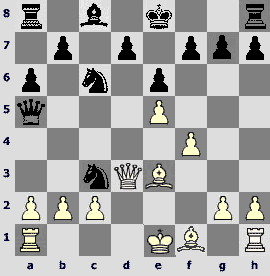
This position seems to be well known. Now White has two evident moves and a risky one. Of course, Izoria decided to run risks.
13.Ґd2?!N This move deserves attention but if Black had played correctly, White would have been satisfied with equal position. However, this move is new and interesting. It also allows us to see a wonderful game! After usual moves the game is more boring: 13.Јxc3 Јxc3+ 14.bxc3 f6 15.exf6 gxf6 16.c4 d5 17.0–0–0 d4 18.Ґxd4 ¤xd4 19.¦xd4 Ґd7 20.Ґe2 ¦c8 21.Ґf3 ¦c7 22.ўd2 ўe7 23.¦b1 b5 24.cxb5 axb5 25.Ґe2І Karjakin – Volokitin, Merida 2005.
For the first time this variation was played in 1972: 13.bxc3 b5 14.Ґe2 Јc7 15.0–0 Ґb7 16.a4 ¤e7 17.axb5 axb5 18.¦xa8+ Ґxa8 19.Јxb5 ¤d5 20.Јc5 Јxc5 21.Ґxc5± Beliavsky – Matulovich, Sombor 1972.
13...¤xe5! The only move. Otherwise, Black has to resign.
14.Јd4.
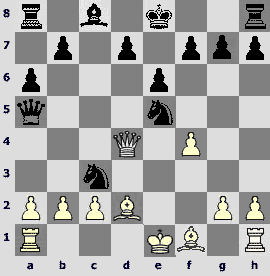
What a nice picture! Black has the extra knight and pawn. To my mind, Gagunashvili could play stronger in this situation. White refused the endgame after 14.Јxc3 Јxc3 15.Ґxc3 ¤g6 (15...¤c6?! 16.Ґxg7 ¦g8 17.Ґc3І) 16.Ґxg7 (ingenious 16.f5?! doesn`t work because of 16...¤h4! 17.Ґxg7? ¦g8 18.f6 ¤f5 19.Ґd3 ¤xg7 20.Ґxh7 ¤h5! 21.Ґxg8 ¤xf6µ, and White`s knight falls into a trap; 17.fxe6 dxe6 18.Ґxg7 ¦g8 19.Ґe5 ¤xg2+ 20.ўf2 ¤h4=) 16...¦g8 17.Ґh6
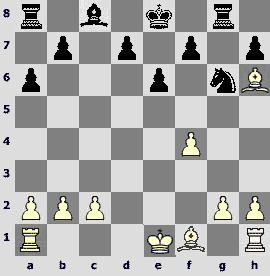
In my point of view, Black`s position is not worse. White`s bishop is not on the best square and Izoria doesn`t have pawns in the center. So Black has a lot of opportunities. He can move either 17...b6 or 17...¤h4 18.Ґg5 ¤f5 19.ўf2 b5 20.Ґd3 Ґb7. It is also possible to play 17...f6?! 18.f5!І (18.Ґd3 ¤h4 19.0–0–0 ¤f5!„) or 17...¤e7!? 18.Ґg5™ b6÷.
14...¤g6? Black plays too slowly. It was necessary to move 14...Јd5! Black made his queen more active by this move. 15.Јxc3 (after 15.Ґxc3 Јxd4 16.Ґxd4 ¤g6 the game comes to the variations that were stated above) 15...Јe4+ 16.Ґe2, perhaps, Black should choose unpretentious 16...¤c6.
The attempt to hunt for the pawns leads to no goods - 16...Јxg2?! 17.0–0–0! The key idea of this position consists in the sacrifice of knight on e2! 17...¤g6 (17...Јxe2 18.fxe5ѓ) 18.Ґd3©, and White has a lot of promising continuations.
The other retreat of the knight leads to the other problems – 16...¤g6 17.Јxg7 Јxg2 18.¦f1 Јxh2. It seems that Black will check and pin White`s king to the rook but the events are far from it! 19.0–0–0! Whitesacrificesagain! 19...Јxe2 20.¦de1, and Zviad has a decisive initiative. For example, 20...Јc4 21.f5 ¦f8 22.fxg6 hxg6 23.Јf6+- and Black couldn`t keep black squares.
After 16...¤c6 17.Јxg7 ¦f8÷ the position is very difficult.
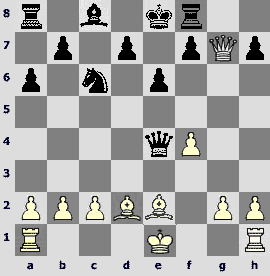
Black doesn`t stand worse. Black`s knight is situated well on c6 because it controls b4-square that could be occupied by White`s bishop. Now White doesn`t have a push f4-f5 either.
14...Јa4 differs from Јd5 because Black can beat c2-pawn in the following variation – 15.Јxc3 (15.Јxe5?! Јe4+ 16.Ґe3 Јxe5 17.fxe5 ¤d5 18.Ґc5і) 15...¤g6 (15...Јe4+!?) 16.Јxg7 Јxc2?! 17.Ґe2©. However, White also has the advantage in this position.
15.Ґxc3. Black had other opportunity - 15.Јxg7!?, but this way is not better - 15...Јd5 (15...Јf5 16.Јxc3!) 16.Јxc3 ¦g8÷.
15...Јf5 16.Јxg7. It is also interesting to try to play for the positional compensation 16.g3!? f6 17.0–0–0, but after 17...¤e7 (17...d5 18.Ґd3 Јh3 19.Јc5±) Black manages to defense this position – 18.Јd6 Јe4 19.Ґd3 Јc6 20.Јa3©.
16...Јxf4. Black has to prevent White`s castling. The point is that White wouldn`t spare his own bishop in this situation (16...Јe4+? 17.Ґe2 Јxg2 18.0–0–0!+-).
17.Ґe2 ¦f8 18.¦f1 Јe4. Black`s queen gets centralized indeed. It is weaker to play 18...Јh4+ 19.¦f2 (it is wrong to move 19.g3? Јxh2, and White is left with nothing) 19...f5 20.g3 Јe7 21.Јh6 d5 22.0–0–0 Ґd7 23.h4!±, Black`s extra pawn is useful and his pieces stands badly.
19.Јxh7 e5.
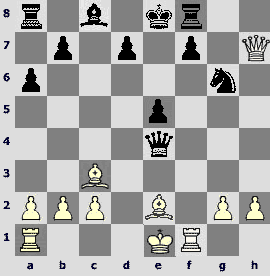
The game approaches its culmination. The opponents made logical moves. It is impossible to dawdle in such situations.
20.0–0–0! This sharp move looks like to be the best one! It wasn`t necessary to defense e2-bishop – 20.¦f2?! After 20...d6! (it is wrong to play 20...d5?! 21.ўf1 Ґe6 22.Ґd3 Јg4 23.Ґxg6 Јxg6 24.Јxg6 fxg6 25.¦xf8+ ўxf8 26.Ґxe5± or 21...Ґd7 22.Ґd3 Ґb5 23.¦e1 Ґxd3+ 24.ўg1 Јa4 25.cxd3І) 21.0–0–0 Јe3+ 22.¦d2 Ґe6÷ White`s pieces lose coordination.
20...Јxe2 21.¦fe1. Actually, Black made a decisive mistake at this moment. His queen has a wide choice of possible retreats and Merab chose the most natural continuation. Black decided to defense e5-pawn. But his next move leads to a forced defeat.
21...Јb5? It was possible to move on f2 - 21...Јf2, but after 22.Ґxe5 ¤xe5 23.¦xe5+ ўd8 24.Јg7 ўc7 25.¦e7ѓ White not only attacks but also has two pawns for c8-bishop that has no moves at all.!
21...Јg4! This move seems to lose the game. So it is wrong to reprobate Merab because he didn`t make it. But there is some kind of idea in this move. Black`s queen takes under control both squares e6 and g6. Now it is possible to defense the king with the bishop from e6. 22.Ґxe5 d5! Just so! 23.Ґd6+ (after 23.¦d4 Јxg2 24.Ґg3+ Ґe6 25.¦xe6+ fxe6 26.Јxg6+ ўd7 White has only threefold repetition 27.Јh7+ ўe8 28.¦d1 ¦c8=) 23...Ґe6 24.¦xd5÷
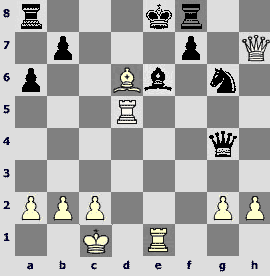
The position is unclear. For example, computer offers cold ўd7 with the further ўc6!!! The point is that nothing can be said against it.
22.Ґxe5! I think that Zviad made this move in a couple of seconds.
22...¤xe5 23.Јh5.
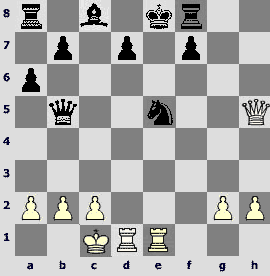
F7-pawn is pinned. I guess that it would be more logical to open the way to c8-bishop...
23...d6?! This move is plain but Black can`t stand up after it. The last chance lay in the escape of Black`s king – 23...ўd8 24.¦xe5 Јb6 25.¦c5!‚ White has a powerful attack but one can`t see a forced defeat.
24.¦xd6 ўe7 25.a4! White cuts the ground from Black`s queen.
25...Јc4 26.Јxe5+ Ґe6 27.b3. This move doesn`t lose the victory but White had an opportunity to win in a brilliant way. It was better to play 27.¦e4! Јa2 (the only chance of Black consists in the activity of his pieces. It is possible to lose simpler after 27...Јc8 28.¦e3+-) 28.c4! (White not only cuts off bishop from queen but also helps his king) 28...Јa1+ 29.ўc2 Јxa4+ 30.ўb1 Јb4 (otherwise, f8-rook would be crushed after the blow on e6) 31.¦xe6+ fxe6 32.Јc7+ ўf6 33.h4!!+-
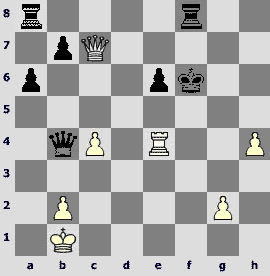
White guarantees the victory by this strong move. Black`s king doesn`t have escape route. It looks like checkmate is not far off.
27...Јc8. It is not a mistake. It was possible to lose in the other way – 27...Јb4 28.¦d4! (White has only threefold repetition after the sacrifice on e6 – 28.¦xe6+ fxe6 29.Јxe6+ ўd8 30.¦d1+ ўc7 31.Јe5+ ўb6 32.a5+ ўa7 33.Јe3+=) 28...Јa3+ (there are no two ways about it – 28...Јb6 29.a5! Јc6 30.¦c4+-) 29.ўb1 ¦ac8 30.¦ed1
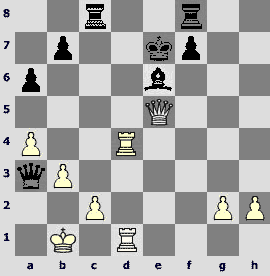
Black`s position is completely hopeless. A3-queen looks like to be useless. Nobody can defense Black`s king. 30...¦g8 31.¦d7+ ўe8 32.¦c7+-.
28.¦e3+- The second rook joins White`s attack. Now Black is collapsed.
28...¦g8 29.¦c3 Јxc3 30.¦xe6+ fxe6 31.Јxc3.
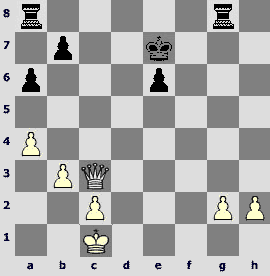
Now White has to incarnate his advantage. White`s queen is really stronger than Black`s rooks. It is also strengthened with two passed pawns. Moreover, Black`s king suffers because of constant checks. I guess that there is no sense to comment next moves. There are special rules of derby and the rivals struggle till the last gun is fired.
31...¦xg2 32.Јb4+ ўf6 33.Јxb7 ¦gg8 34.a5 e5 35.Јf3+ ўe6 36.h4 ¦gf8 37.Јg4+ ўd6 38.h5 ¦ae8 39.Јb4+ ўe6 40.Јc4+ ўf5 41.Јxa6 e4 42.Јg6+ ўf4 43.ўd2.
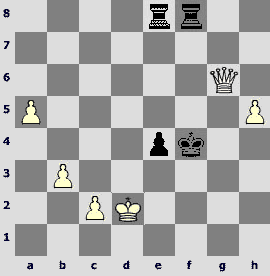
43...ўf3 44.ўe1 e3 45.a6 e2 46.a7 ўe3 47.Јg1+ ўf4 48.b4 ¦f5 49.Јf2+ ўg5 50.a8Ј¦xa8 51.Јg2+.
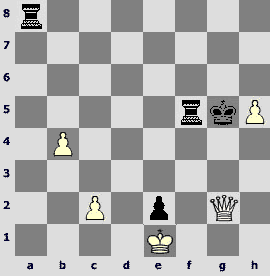
1–0
